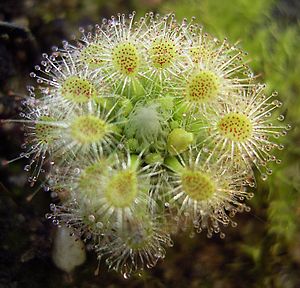Drosera hyperostigma
| Drosera hyperostigma | ||||||||||||
|---|---|---|---|---|---|---|---|---|---|---|---|---|

Drosera hyperostigma , Habitus (in culture) |
||||||||||||
| Systematics | ||||||||||||
|
||||||||||||
| Scientific name | ||||||||||||
| Drosera hyperostigma | ||||||||||||
| NGMarchant & Lowrie |
Drosera hyperostigma is a carnivorous plant of the genus sundew ( Drosera ). It belongs to the group of so-called dwarf sundews and isnative tosouthwestern Australia .
description
Drosera hyperostigma is a perennial herbaceous plant . This forms a compact rosette of horizontal leaves with a diameter of about 2.5 cm. The stem axis is up to 5 mm long and covered with the withered leaves of the preseason.
The stipules are ovate, 5 mm long and 5 mm in diameter at the base. The stipules themselves are 4.5 mm long, 3 mm wide and three-lobed. The middle lobe is divided into 3 segments.
The leaf blades are elliptical, 2.5 mm long and 2 mm wide with some hairs on the underside. The longer tentacle glands are on the edge, the shorter ones on the inside. The leaf stalks are up to 4 mm long, 0.8 mm wide and taper abruptly to 0.6 mm near the leaf blade. The entire shaft is covered with tiny hairs.
Flowering time is October. The flower stalk is up to 5 cm long and sparse at the base, and more and more densely covered with tiny hairs towards the tip. The inflorescence is a coil of 6 to 8 flowers on approximately 1.5 mm long pedicels. The broadly egg-shaped sepals are 3 mm long and 2 mm wide. The edges are smooth on the lower half, the rest is irregularly notched. The surface is irregularly covered with cylindrical red-headed glands. The petals are metallic-orange, black-brown on the lower half, inverted ovoid, slightly notched at the tip, 7 mm long and 6.5 mm wide.
The five stamens are 2.5 mm long. The threads are black-brown on the lower half, the rest is white, the anthers are white and the pollen are yellow. The noticeably gray (not black) ovary is broadly inverted ovoid, 0.5 mm long and 0.9 mm in diameter. The 3 black-brown, horizontally elongated styluses are 0.5 mm long and only 0.05 mm in diameter. The scars are 0.5 mm long and 0.2 mm in diameter.
The formation of brood scales is typical for dwarf sundews : the egg-shaped, 0.7 mm thick brood scales are formed in large numbers from late November to early December and are approx. 1.7 mm long and 1.1 mm wide.
Distribution, habitat and status
Drosera hyperostigma occurs only on a small area in the extreme southwest of Australia. The plant thrives there on soils containing laterite and silica in light, open forest.
Systematics
The name hyperostigma comes from the Greek and refers to the fact that the scars are at the outer end of the stylus ("hyper" = over; "stigma" = scar).
literature
- Allen Lowrie : Carnivorous Plants of Australia. Volume 2. University of Western Australia Press, Nedlands 1989, ISBN 0-85564-300-5 , p. 66.
